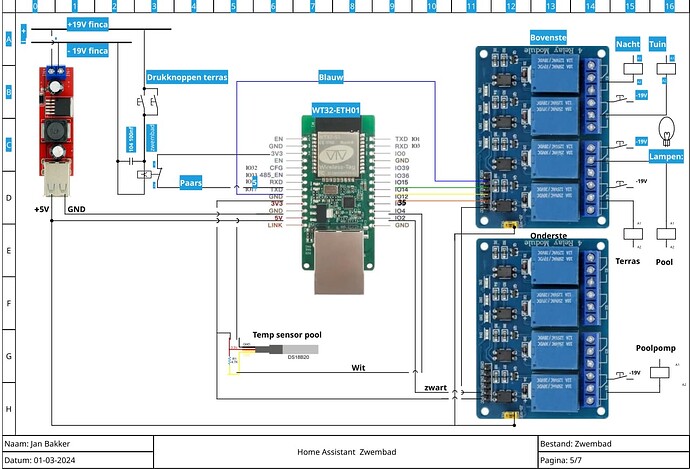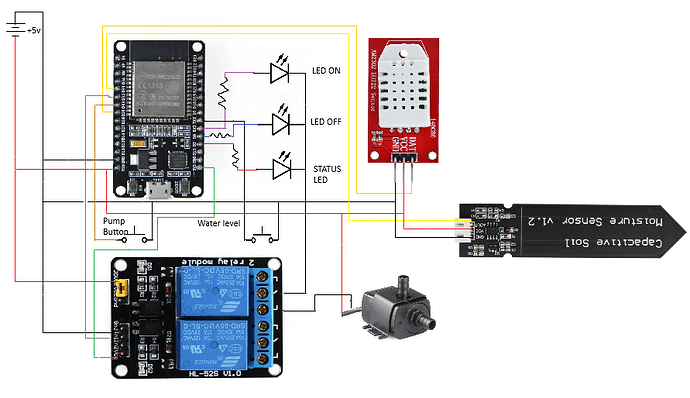Hi everyone, I’ve been playing with ESP32s for a short while, but I’ve learned in a short time.
I’m designing a small irrigation system for my plants, before assembling it I’m trying everything on a BreadBoard, and everything seems to be going well, except when I turn on the pump, in that case the ESP32 goes crazy randomly turning the relay and LEDs on and off, and I find the message in the log: “[dht:174]: Requesting data from DHT failed!”
The whole system is powered by 5v with a MeanWell DR-15-5 power supply, the voltages are stable and perfect.
If I try with a motor like this → Mabuchi Motor RF-300 then the problem doesn’t occur, even with 3 of these turned on at the same time.
I can’t understand why it happens and how to solve it.
This is my esphome yaml:
esphome:
name: "irrigatore"
friendly_name: Irrigatore
area: Home
on_boot:
priority: 800
then:
- switch.turn_off: Pompa
on_shutdown:
then:
- switch.turn_off: Pompa
esp32:
board: esp32dev
framework:
type: esp-idf
# Enable logging
logger:
# Enable Home Assistant API
api:
encryption:
key: "NB+M8OzBcEpB0MA2Tl7jhNjD/qzlPlc77z5nkjjCH2k="
ota:
- platform: esphome
password: "c06bf487b779e1626a91b3d5a5b279df"
wifi:
ssid: !secret wifi_ssid
password: !secret wifi_password
enable_btm: true
enable_rrm: true
# Enable fallback hotspot (captive portal) in case wifi connection fails
ap:
ssid: "Irrigatore - Fallback Hotspot"
password: "Qhckalnovka3"
captive_portal:
time:
- platform: sntp
id: my_time
timezone: Europe/Rome
binary_sensor:
- platform: status
name: "Irrigazione - Stato Rete"
#Pump button
- platform: gpio
pin:
number: GPIO33
inverted: true
mode:
input: true
pullup: true
name: "Pulsante Pompa manuale"
on_press:
then:
- switch.toggle: Pompa
- light.toggle: led_on
- light.toggle: led_off
- logger.log: Pompa in modalita' manuale
- platform: gpio
pin:
number: GPIO17
inverted: false
mode:
input: true
pullup: true
name: "Recipiente acqua"
on_press:
then:
- light.turn_on: led_on
- light.turn_on: led_off
- logger.log: Bidone dell'acqua vuoto
status_led:
pin: GPIO2
#Pump Relay
switch:
- platform: gpio
name: "Pompa"
pin:
number: GPIO32
inverted: true
icon: "mdi:sprinkler"
id: Pompa
restore_mode: always_off
#Pump LED
output:
- id: ledon
platform: gpio
pin: GPIO16
- id: ledoff
platform: gpio
pin: GPIO4
light:
- platform: binary
id: led_on
name: "LED Pompa ON"
output: ledon
icon: "mdi:led-on"
restore_mode: always_off
- platform: binary
id: led_off
name: "LED Pompa OFF"
output: ledoff
icon: "mdi:led-off"
restore_mode: always_on
sensor:
- platform: wifi_signal
name: "Irrigazione WiFi Signal"
update_interval: 30s
id: wifi_signal_db
- platform: copy
source_id: wifi_signal_db
name: "WiFi Signal Percent"
filters:
- lambda: return min(max(2 * (x + 100.0), 0.0), 100.0);
unit_of_measurement: "%"
entity_category: "diagnostic"
device_class: ""
- platform: uptime
name: "Irrigazione Uptime"
id: uptime_sensor
update_interval: 60s
- platform: internal_temperature
name: "Temperatura del sistema"
icon: "mdi:thermometer"
#External temp sensor
- platform: dht
pin: GPIO25
temperature:
name: "Irrigazione Temperature"
icon: "mdi:thermometer"
humidity:
name: "Irrigazione Humidity"
icon: "mdi:water-percent"
update_interval: 30s
#Soil humidity sensor
- platform: adc
pin: GPIO35
name: "Soil Humidity Sensor"
id: soil_humidity
accuracy_decimals: 0
update_interval: 5s
icon: "mdi:flower"
device_class: "moisture"
unit_of_measurement: "%"
attenuation: 12db
filters:
- calibrate_linear:
- 2.25 -> 0
- 0.97 -> 100
- lambda: |
if (x < 0) return 0;
else if (x > 100) return 100;
else return (x);
text_sensor:
- platform: version
name: "Irrigatore version"
- platform: wifi_info
ip_address:
name: "Irrigatore IP"
update_interval: 60s
bssid:
name: "Irrigatore BSSID"
update_interval: 60s
ssid:
name: "Irrigatore SSID"
update_interval: 60s
button:
- platform: factory_reset
name: "Restart with Factory Default Settings"
- platform: restart
name: "Irrigatore Riavvia"
- platform: shutdown
name: "Irrigatore Spegni"
icon: "mdi:power"
- platform: safe_mode
name: "Irrigatore Safe Mode"


